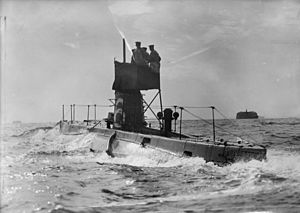HMS B6
 HMS B6 in the Solent
| |
| History | |
|---|---|
| Name | HMS B6 |
| Builder | Vickers |
| Launched | 30 November 1905 |
| Completed | 3 March 1906 |
| Fate | Sold for scrap, 1921 |
| General characteristics | |
| Class and type | B-class submarine |
| Displacement |
|
| Length | 142 ft 3 in (43.4 m) |
| Beam | 12 ft 7 in (3.8 m) |
| Draught | 11 ft 2 in (3.4 m) |
| Installed power | |
| Propulsion |
|
| Speed |
|
| Range | 1,000 nmi (1,900 km; 1,200 mi) at 8.7 kn (16.1 km/h; 10.0 mph) on the surface |
| Test depth | 100 feet (30.5 m) |
| Complement | 2 officers and 13 ratings |
| Armament | 2 × 18 in (450 mm) bow torpedo tubes |
HMS B6 was one of 11 B-class submarines built for the Royal Navy in the first decade of the 20th century. The boat survived the First World War and was sold for scrap in 1921.
Design and description
The B class was an enlarged and improved version of the preceding A class. The submarine had a length of 142 feet 3 inches (43.4 m) overall, a beam of 12 feet 7 inches (3.8 m) and a mean draft of 11 feet 2 inches (3.4 m). They displaced 287 long tons (292 t) on the surface and 316 long tons (321 t) submerged. The B-class submarines had a crew of two officers and thirteen ratings.[1]
For surface running, the boats were powered by a single 16-cylinder 600-brake-horsepower (447 kW) Vickers petrol engine that drove one propeller shaft. When submerged the propeller was driven by a 180-horsepower (134 kW) electric motor. They could reach 12 knots (22 km/h; 14 mph) on the surface and 6.5 knots (12.0 km/h; 7.5 mph) underwater.[1] On the surface, the B class had a range of 1,000 nautical miles (1,900 km; 1,200 mi) at 8.7 knots (16.1 km/h; 10.0 mph).[2]
The boats were armed with two 18-inch (45 cm) torpedo tubes in the bow. They could carry a pair of reload torpedoes, but generally did not as they would have to remove an equal weight of fuel in compensation.[3]
Construction and career
B6 was built by Vickers at their Barrow-in-Furness shipyard, launched 30 November 1905 and completed 3 March 1906. The boat was deployed to the Mediterranean soon after the outbreak of World War I. Due to the lack of spare parts this group of submarines were not used after September 1915. In 1917 the Italian Navy converted B6 into to surface patrol boat S6 to serve in the Adriatic. The boat was sold in 1921 to Messrs. Francotosti, Malta.
Notes
References
- Akermann, Paul (2002). Encyclopaedia of British Submarines 1901–1955 (reprint of the 1989 ed.). Penzance, Cornwall: Periscope Publishing. ISBN 1-904381-05-7.
- Colledge, J. J.; Warlow, Ben (2006) [1969]. Ships of the Royal Navy: The Complete Record of all Fighting Ships of the Royal Navy (Rev. ed.). London: Chatham Publishing. ISBN 978-1-86176-281-8.
- Gardiner, Robert; Gray, Randal, eds. (1984). Conway's All the World's Fighting Ships: 1906–1921. Annapolis, Maryland: Naval Institute Press. ISBN 0-85177-245-5.
{{cite book}}: Unknown parameter|lastauthoramp=ignored (|name-list-style=suggested) (help) - Harrison, A. N. (January 1979). "The Development of HM Submarines From Holland No. 1 (1901) to Porpoise (1930) (BR3043)". Submariners Association: Barrow in Furness Branch. Retrieved 19 August 2015.
- Wilson, Michael (1981). "The British 'B' Class Submarine". In Roberts, John (ed.). Warship Volume V. London: Conway Maritime Press. pp. 38–44, 74–79. ISBN 0-85177-244-7.
